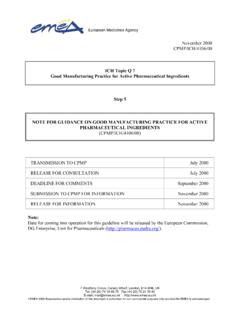Transcription of HMPC Guideline on GACP - ema.europa.eu
1 European Medicines Agency Evaluation of Medicines for Human Use London, 20 February 2006. Doc. Ref. EMEA/HMPC/246816/2005. COMMITTEE ON HERBAL medicinal PRODUCTS. (HMPC). Guideline ON GOOD AGRICULTURAL AND COLLECTION PRACTICE (GACP) FOR. STARTING MATERIALS OF HERBAL ORIGIN. ADOPTION BY HMPC FOR RELEASE FOR July 2005. CONSULTATION. END OF CONSULTATION (DEADLINE FOR COMMENTS) 30 October 2005. AGREED BY HMPC QUALITY DRAFTING GROUP January 2006. ADOPTION BY HMPC 12 January 2006. DATE FOR COMING INTO EFFECT 1 August 2006. Note: the previous Herbal medicinal Products Working Party Points to consider on GACP is now reintroduced as a HMPC Guideline .
2 Only minor changes have been made to its contents further to the public consultation. 7 Westferry Circus, Canary Wharf, London, E14 4HB, UK. Tel. (44-20) 74 18 84 00 Fax (44-20) 75 23 70 51. E- mail: EMEA 2006 Reproduction and/or distribution of this document is authorised for non commercial purposes only pdovided the EMEA is acknowledged Guideline ON GOOD AGRICULTURAL AND COLLECTION PRACTICE FOR. STARTING MATERIALS OF HERBAL ORIGIN. TABLE OF CONTENTS. 1 Introduction 2 General 3 Quality Assurance 4 Personnel and Education 5 Buildings and Facilities 6 Equipment 7 Documentation 8 Seeds and Propagation material 9 Cultivation 10 Collection 11 Harvest 12 Primary processing 13 Packaging 14 Storage and Distribution EMEA 2006.
3 2/11. 1. INTRODUCTION. In order to ensure appropriate and consistent quality of medicinal plant/herbal substances1 it is necessary to establish good agricultural and collection practice for herbal starting materials (GACP). The concept of Good Manufacturing Practice for the manufacture, processing, packaging and storage of Active Pharmaceutical Ingredients (APIs) also applies to medicinal plants/herbal substances. In the case of herbal preparations 2 the production and primary processing of the medicinal plant/herbal substance has a direct influence on the quality of the API.
4 Due to the inherent complexity of naturally grown medicinal plants/herbal substances and the limited analytical techniques to characterise constituents solely by chemical or biological means, reproducible quality of starting materials of herbal origin requires an adequate quality assurance system for the collection and/or cultivation, harvest and primary processing. Collection in wild habitats, , may present special problems, especially with regard to confusion with similar plants, environmental damage, lack of control and poorly qualified personnel.
5 The following Guideline on good agricultural and collection practice does not fall directly under GMP guidelines in the traditional sense. However, these considerations should be used as a basis for the establishment of such an appropriate quality assurance system. 2. GENERAL. This document is intended to address the specific concerns of growing, collecting and primary processing of medicinal plants/herbal substances that are used for medicinal purposes. It addresses specific issues associated with agricultural production and collection of medicinal plants/herbal substances in the wild.
6 These considerations should be read in connection with GMP guidelines for APIs and should apply to all methods of production including organic production in accordance with regional and/or national regulations. These provide addit ional standards for the production and processing of medicinal plants/herbal substances insofar as they mainly focus on identifying those critical production steps that are needed to ensure good quality. The main aim is to ensure consumer safety by establishing appropriate quality standards for medicinal plants/herbal substances.
7 Especially important aspects are that medicinal plants/herbal substances: - are produced hygienically, in order to reduce microbiological load to a minimum, - are handled with care so that medicinal plants/herbal substances are not adversely affected during collection, cultivation, processing and storage. During the course of the production process medicinal plants/herbal substances and their preparations are exposed to a large number of microbiological and other contaminants. This Guideline provides recommendations for producers to reduce contamination to a minimum.
8 1. The term herbal substance should be considered as equivalent to the term herbal drug as defined in the European Pharmacopoeia 2. The term herbal preparation should be considered as equivalent to the term herbal drug preparation as defined in the European Pharmacopoeia EMEA 2006. 3/11. Considerations and recommendations in this Guideline are intended for all participants from primary producers to traders and processors. Therefore, producers, traders and processors of medicinal plants/herbal substances should comply with these considerations, document all relevant activities in batch documentation and demand that their partners do likewise, unless it can be justified otherwise.
9 Growers and collectors of medicinal plants/herbal substances must ensure that they avoid damage to existing wildlife habitats. CITES (Convention on International Trade in Endangered species of Wild Fauna and Flora) must be adhered to. 3. QUALITY ASSURANCE. Agreements between producers and buyers of medicinal plants/herbal substances with regard to quality such as content of active principle, macroscopical and olfactory properties, limit values for microbial contamination, chemical residues and heavy metals etc., must be based on recognised regional and/or national specifications and should be laid down in written form.
10 4. PERSONNEL AND EDUCATION. All primary processing procedures should fully conform with regional and/or national guidelines on food hygiene and personnel entrusted with handling of medicinal plants/herbal substances should be required to have a high degree of personal hygiene (including personnel working in the field) and have received adequate training regarding their hygiene responsibilities. The welfare of all staff involved in growing and processing should be ensured. Personnel must be protected from contact with toxic or potentially allergenic medicinal plants/herbal substances by means of adequate protective clothes.

















